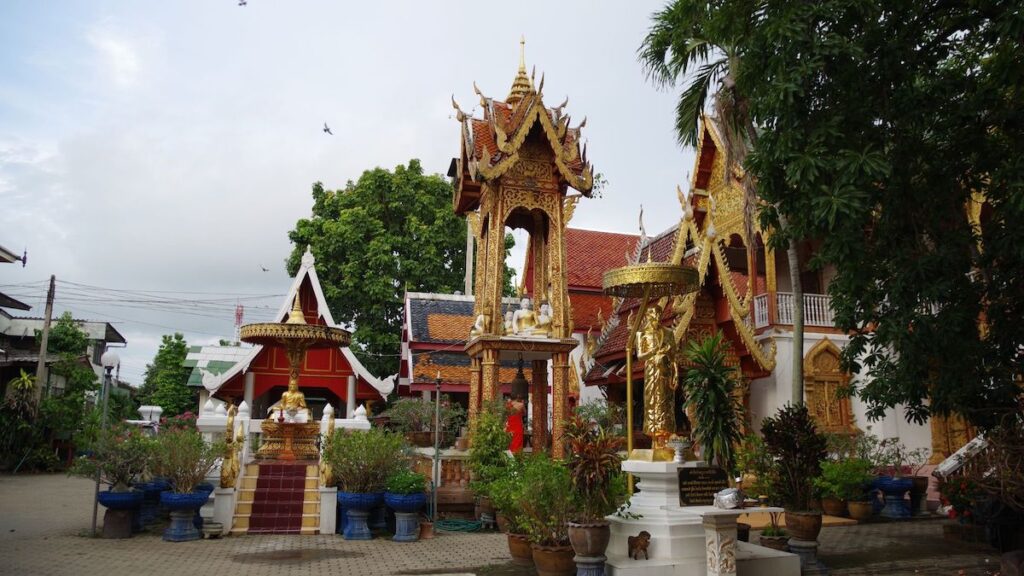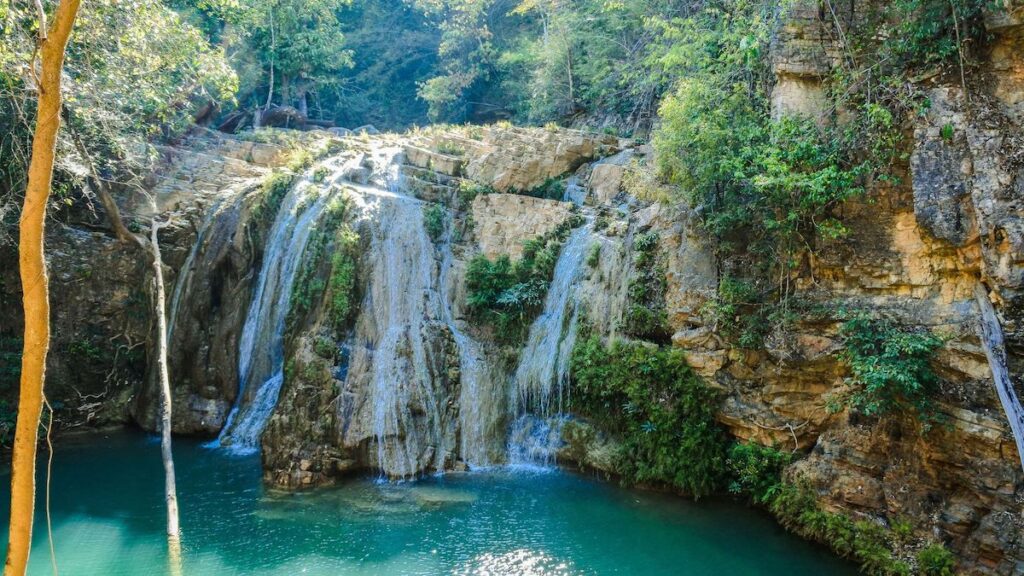Lamphun
Lamphun, just 26 km from Chiang Mai, is probably the oldest inhabited city in Thailand. Nestled in the heart of northern Thailand lies the charming town of Lamphun. Often overshadowed by its bigger and glitzier counterparts, Lamphun offers a unique experience for those seeking a more authentic cultural encounter. Here, you can stroll down the town’s narrow streets flanked by traditional wooden houses, marvel at the intricate designs of ancient temples or sample the local delicacies at the bustling markets.
The town is steeped in history and is known for its significant role in the formation of the Lanna kingdom, one of the most powerful in Southeast Asia during the thirteenth century. Visiting Lamphun is like taking a step back in time and immersing yourself in the rich and vibrant culture of northern Thailand.
History of Lamphun
Legend states that this fortified settlement was founded in 660 AD, making it almost twice as old as the Lanna capital to the north and 1,122 years older than Bangkok.
Although historians question this date and prefer the more conservative estimate of 950 AD, it is nevertheless a lasting seat of power and influence in Southeast Asia.
 Lamphun was established by Buddhist monks from Lopburi during the reign of legendary Queen Chamadevi and served as the capital of the Haripunchai Kingdom. Haripunchai was the center of Mon culture until 1281 when it was eventually conquered by King Mangrai of Lan Na.
Lamphun was established by Buddhist monks from Lopburi during the reign of legendary Queen Chamadevi and served as the capital of the Haripunchai Kingdom. Haripunchai was the center of Mon culture until 1281 when it was eventually conquered by King Mangrai of Lan Na.
The ashes of Queen Chamadevi are supposed to lie in the Wat of her name. Lamphun’s main morning market, in the southwest of the city, boasts a statue of the Queen where local people still make offerings.
Legend has it that King Mangrai was visited by some Mon merchants and, upon hearing about the wealth of Lamphun, decided to conquer the city, even though his councilors advised against it.
But as Lamphun proved impossible to take the city by force, the king sent a skillful merchant by the name of Ai Fa to gain the confidence of the reigning monarch King Yi Ba. In time, it is said, he became Chief Minister and managed to undermine the ruler’s authority.
Best Lamphun Tour from Chiang Mai:
And so in 1281, when the citizens of Lamphun disenchanted, King Mangrai defeated the Mon kingdom and added northern Thailand’s foremost city to his kingdom. Yi Ba, the last Hariphunchai king, was forced to flee south to seek refuge in Lampang. Lamphun was then incorporated into the new Lanna Kingdom and Ai Fa was appointed King. Mangrai began building his fortress of Wiang Kum Kam as the new Lanna capital.
Things to Do in Lamphun
Sleepy Lamphun is today generally visited as an enjoyable and rewarding day trip from the northern capital and boasts lotus-filled moats and among the most distinguished historical architecture in the Kingdom. Although many of the most ancient temples have fallen into disrepair, Lamphun remains a popular spot for both Thai and international tourists.
In fact, many people say that the journey from Chiang Mai to Lamphun is more enjoyable than the city itself. Travelers should avoid the gargantuan new Superhighway and instead head south along the old Chiang Mai – Lamphun Road Highway 106. This route, which originally linked Chiang Mai’s namesake southern gate and Lamphun’s northern Elephant Crush Gate, is lined by 30m yang trees, small farms, fruit orchards, and paddy fields.
This historic road passes through the artisans’ village of Saraphi, famous for bamboo furniture and basketry. Numerous shops selling these products stand lined the road with garden restaurants also interspersing the lofty foliage.
There is not a great deal remaining of Lamphun’s ancient city walls, although the well-preserved moat still surrounds the Old City towards the north, west, and south. The east is flanked by the slow-flowing waters of the Kuang River. Although this shallow waterway once offered protection from invaders, now there is only a kids’ boating park and shady banks for fishing.
History buffs will find the well-maintained and informative provincial museum offers an insight into the layout of the city of Lamphun. Within are various displays of fine bronzes, terracottas, and stuccoes dating back to Mon times plus masks and carvings of figurines with the classic enigmatic grin and fierce eyes of Haripunchai art.
Luang Pa Wiang Cave
Come explore the breathtaking beauty of Luang Pa Wiang Cave! It’s located around 20 kilometers away from the town of Lamphun.
Known locally as Tum Lhuang, this natural masterpiece boasts jaw-dropping stalagmites and stalactites, and is steeped in the rich history and culture of Thailand.
Venture through its eight chambers, each with its own unique name and character. From the awe-inspiring, fully-lit Lam Rommani chamber to the mysterious Noen Salai Ngarm Ta, with its magnificent earthen mound, each section is a world of its own.
Best of all, you can see Buddha and other religious sculptures of varying sizes, adding a spiritual dimension to your journey through this underground wonderland.
For an admission fee of just 10 baht, you can enjoy this natural gem and even have electricity available. You won’t want to miss this unforgettable experience!
Wat Phra That Haripunchai
 Just across from the museum, on the eastern edge of Inthayongyot Road, lies an amazing sight to behold: Wat Phra That Haripunchai. This temple is straight out of a dream, founded in 1044 by none other than King Athitayaraj of Haripunchai. And, even after all these years, it’s still unparalleled in all of northern Thailand.
Just across from the museum, on the eastern edge of Inthayongyot Road, lies an amazing sight to behold: Wat Phra That Haripunchai. This temple is straight out of a dream, founded in 1044 by none other than King Athitayaraj of Haripunchai. And, even after all these years, it’s still unparalleled in all of northern Thailand.
Wat Phra That Haripunchai features on the reverse of Thailand’s one satang coin. Legendary stories claim that the queen’s personal quarters are enclosed within the main 46-meter-high copper-covered chedi with a gold umbrella at its summit. If that was the truth, however, Chamadevi’s quarters would not have been big enough to swing a cat!
Koh Luang Waterfall
 Escape into the lush embrace of Koh Luang Waterfall of Mae Ping National Park, Lamphun, and Tak provinces. It’s located 1.5 hours away from Lamphun town.
Escape into the lush embrace of Koh Luang Waterfall of Mae Ping National Park, Lamphun, and Tak provinces. It’s located 1.5 hours away from Lamphun town.
A mesmerizing natural wonder that enthuses your senses with its serene, green-blue waters, and a vast array of vivid fishes. The undulating falls are 20 meters tall, with seven levels of stunning streams that culminate in a blue basin.
Explore the limestone rock formations, and discover the intricate features of stalagmites, and stalactites. Begin an adventure of a lifetime with amateur spelunkers who brave Koh Luang caves. In February to May, the striking turquoise hue of water dazzles visitors, while in November to February, it’s the cerulean that enchants your eyes. Beware, though, during the rainy season, when the water is cloudy green, swimming is not allowed due to safety reasons. Get lost in the Kaleidoscope of Koh Luang Waterfall, a must-visit attraction in Northern Thailand.
Lamphun, surrounded by lush countryside, orchards, and rice paddy, is the site of a popular longan fruit festival every August.
